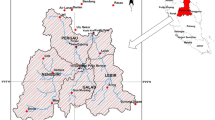Abstract
Assessment of the environmental impact of Non Point Source (NPS) pollutants on a global, regional and localized scale is the key component for achieving sustainability of agriculture as well as preserving the environment. The knowledge and information required to address the problem of assessing the impact of NPS pollutants like Nitrogen (N), Phosphorus (P), etc., on the environment crosses several sub-disciplines like remote sensing, Geographical Information System (GIS), hydrology and soil science. The remote sensing data, by virtue of its potential like synopticity, multi-spectral and multi-temporal capability, computer compatibility, besides providing almost real time information, has enhanced the scope of automation of mapping dynamic elements, such as land use/land cover, degradation profile and computing the priority categorisation of sub-watersheds. The present study demonstrates the application of remote sensing, GIS and distributed parameter model Agricultural Non-Point Source Pollution Model (AGNPS) in the assessment of hazardous non-point source pollution in a watershed. The ARC-INFO GIS and remote sensing provided the input data to support modelling, while the AGNPS model predicted runoff, sediment and pollutant (N and P) transport within a watershed. The integrated system is used to evaluate the sediment pollution in about 2700 ha Karso watershed located in Hazaribagh area of Jharkhand State, India. The predicted values of runoff and sediment yield copared reasonably well with the measured values. It is important to emphasize that this study is not intended to characterise, in an exhaustive manner. Instead, the goal is to illustrate the implications and potential advantages of GIS and remote sensing based Hydrology and Water quality (H/WQ) modelling framework.
Similar content being viewed by others

References
Arnold, J.G., Williams, J.R., Nicks, A.D. and Sammons, N.B. (1990). SWRRB: A Basin scale Simulation Model for Soil and Water Resource Management. Texas A & M Univ. press, College station, TX.
Baxter, E.V. and Scott Needham. (1993). Non-point pollution model sensitivity to grid cell size. J. Water Resour. Plan. Mgt.,2: 141–157.
Beasley, D.B. and Hugins, L.F. (1982). ANSWERS: Areal Non-point Source Watershed Environmental Response Simulation: User’s manual, USEPA Rep. 905/9-82-001. USEPA, Chicago, IL.
Burrough, P.A. (1986). Principles of Geographical Information Systems for Land Resource Assessment. Clarendon Press, Oxford, UK.
Corwin, D.L. and Wagenet, R.J. (1996). Applications of GIS to the modelling of non-point source pollutants in the vadose zone: A conference overview. J. Envi. Qual.,25:403–411.
Frere, M.H., Ross, J.D. and Lane, L.J. (1980). The nutrient sub model. CREAMS - A Field Scale Model for Chemicals, Runoff and Erosion from Agricultural Management Systems (W.G. Knisel (ed.). USDA Conservation Res. Rep USDA-ARS, Washington, D.C. 26, pp.65–85.
Humenik, F.J., Smolen, M.D. and Dressing, S.A. (1987). Pollution from non-point sources: Where we are. Where we should go. Envi. Sci. Tech.21(8): 737–742.
Jensen, J.R. (1986). Introductory Digital Image Processing: A Remote Sensing Perspective. Prentice-Hall, Englewood Cliffs, N. J., United States of America, pp. 254-271.
Knisel, W.G. (ed.). (1980). CREAMS: A field scale model for Chemicals, Runoff and Erosion from Agricultural Management Systems. Cons. Res. Rep. 20. USDA-ARS, Washington, DC.
Marble, D.F., Peuquet, D.J., Boyle, A.R., Bryant, N., Calkins, H.W., Johnson, T. and Zobrist, A. (1983). Geographic Information Systems and Remote Sensing. Manual of Remote Sensing, American Society of Photogrammetry, Falls Church, Virginia, 1:923–958.
Mitchell, J.K., Engel, B.A., Srinivasan, R. and Wang, S.Y. (1993). Validation of AGNPS for small watersheds using an integrated AGNPS GIS system. Water Res. Bull. (AWRA),5: 833–842.
OEDC, (1986). Water Pollution by Fertilizers and Pesticides,. Oxford & IBH Publishing Co. Ltd., pp.144.
Oliver, G. and Solomon, R. (1990). The use of surface runoff models for water quality decisions-user’s perspective. In Proc. Int. Symp. Water Quality Modelling of Agricultural Non-Point Sources, D.G. Decoursey (ed.). Logan, UT. June, 19-23, 1988. ARS-81 USDA-ARS, Washington, DC, pp. 197-204
Porwal, M.C. and Pant, D.N. (1989). Forest cover type and land use mapping using Landsat thematic mapper false colour composite- A case study for Chakrata in western Himalayas, U.P. Indian J. Remote Sensing,17(1): 33–40.
Ragan, R.M. and Jackson, T.J. (1980). Runoff synthesis using Landsat and SCS model. J. Hydraulic Divn. ASCE,106(HY5): 667–678.
Reusing, M., Schneider, T. and Ammer, U. (2000). Modelling soil loss rates in the Ethiopian highlands by integration of high resolution MOMS-02/D2-stereo-data in a GIS. Int. J. Remote Sensing.21(29): 1885–1896.
Rose, C.W., Dickinson, W.T., Jorgensen, S.E. and Ghadiri, H. (1990). Agricultural non-point source runoff and sediment yield water quality (NPS SWQ) models: Modeler’s perspective. In Proc. Int. Symp. Water Quality Modelling of Agricultural Non-point Sources, D.G. Decoursey (ed.), Logan, UT, June, 19-23, 1988. ARS-81. USDA-ARS, Washington, DC, pp. 145–170
Short, N.M. (1982). The Landsat Tutorial Workbook- Basics of Satellite Remote Sensing. United States National Aeronautics and Space Administration, Washington, D.C., 1982, pp.277–307.
Terry, J.L. (1990). Agricultural best management practices and groundwater protection. J. Soil Water Cons.,45(2): 201–206.
Tim, U.S. and Jolly, R. (1994). Evaluating agricultural non-point source pollution using integrated Geographic Information Systems and Hydrologic/ Water Quality Model. J. Envi. Qual.,23: 25–35.
Tiwari, K.N., Kumar, P.N., Sebastian, M. and Pal, D.K. (1991). Hydrologic modelling for runoff determination: Remote sensing techniques. Int. Water Res. Dev.,7(3): 178–184.
Wischmeier, W.H. and Smith, D.D. (1978). Predicting rainfall runoff losses. USDA Handbook. 537. U.S. Gov. Print. Office, Washington, DC.
Young, R.A., Onstad, C.A., Bosch, D.D. and Anderson, W.P. (1987). AGNPS: Agricultural non-point source pollution model. A watershed analysis tool. Cons. Res. Rep. 35. USDA-ARS, Washington, DC.
Author information
Authors and Affiliations
About this article
Cite this article
Chowdary, V.M., Yatindranath, Kar, S. et al. Modelling of non-point source pollution in a watershed using remote sensing and gis. J Indian Soc Remote Sens 32, 59–73 (2004). https://doi.org/10.1007/BF03030848
Received:
Revised:
Issue Date:
DOI: https://doi.org/10.1007/BF03030848



